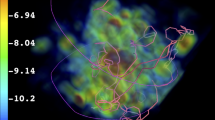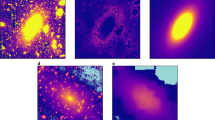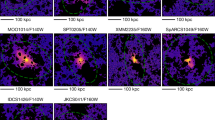Abstract
Clusters of galaxies are visible tracers of the network of matter in the Universe, marking the high-density regions where filaments of dark matter join together. When observed at X-ray wavelengths these clusters shine like cosmic lighthouses, as a consequence of the hot gas trapped within their gravitational potential wells. The X-ray emission is linked directly to the total mass of a cluster, and so can be used to investigate the mass distribution for a sizeable fraction of the Universe. The picture that has emerged from recent studies is remarkably consistent with the predictions for a low-density Universe dominated by cold dark matter.
This is a preview of subscription content, access via your institution
Access options
Subscribe to this journal
Receive 51 print issues and online access
$199.00 per year
only $3.90 per issue
Buy this article
- Purchase on Springer Link
- Instant access to full article PDF
Prices may be subject to local taxes which are calculated during checkout






Similar content being viewed by others
References
Abell, G. O. The distribution of rich clusters of galaxies. Astrophys. J. Suppl. 3, 211–278 ( 1958).
Abell, G. O., Corwin, H. G. Jr & Olowin, R. P. A catalog of rich clusters of galaxies. Astrophys. J. Suppl. 70, 1– 138 (1989).
Zwicky, F., Herzog, E., Wild, P., Karpowicz, M. & Kowal, C. Catalogue of Galaxies and of Clusters of Galaxies (California Institute of Technology, Pasadena, 1961–68 ).
Retzlaff, J., Borgani, S., Gottlöber, S., Klypin, A. & Müller, V. Constraining cosmological models with cluster power spectra. New Astron. 3, 631–646 (1998).
Miller, C. J. & Batuski, D. J. The power spectrum of rich clusters to scales approaching 1000 Mpc. Astrophys. J. (submitted); also preprint astro-ph/0002295 at 〈xxx.lanl.gov〉 ( 2000).
Zwicky, F. Helv. Phys. Acta. 6, 110 (1933 ).
Smith, S. The mass of the Virgo cluster. Astrophys. J. 83, 23–30 (1936).
Evrard, A. E. The intracluster gas fraction in X-ray clusters—Constraints on the clustered mass density. Mon. Not. R. Astron. Soc. 292, 289–297 (1997).
Hasinger, G. et al. The ROSAT Deep Survey. I. X-ray sources in the Lockman Field. Astron. Astrophys. 329, 482– 494 (1998).
Ebeling, H. et al. Properties of the X-ray-brightest Abell-type clusters of galaxies (XBACs) from ROSAT All-Sky Survey data—I. The sample. Mon. Not. R. Astron. Soc. 281, 799–829 (1996).
Ebeling, H. et al. The ROSAT brightest cluster sample—I. The compilation of the sample and the cluster log N-log S distribution. Mon. Not. R. Astron. Soc. 301, 881–914 (1998).
De Grandi, S. et al. (the REFLEX Team) A flux-limited sample of bright clusters of galaxies from the southern part of the ROSAT All-Sky Survey: The catalog and LOG N-log S. Astrophys. J. 514, 148– 163 (1999).
Böhringer, H. et al. (the REFLEX Team) The ROSAT-ESO flux limited X-ray (REFLEX) galaxy cluster sample. Astron. Astrophys. (submitted); also as preprint astro-ph/001226 at 〈xxx.lanl.gov〉 ( 2000).
Böhringer, H. et al. The northern ROSAT All-Sky (NORAS) galaxy cluster survey I: X-ray properties of clusters detected as extended X-ray sources. Astrophys. J. Suppl. 129, 435–474 (2000).
de Bernardis, P. et al. (BOOMERANG Collaboration) A flat Universe from high-resolution maps of the cosmic microwave background radiation. Nature 404, 955–959 (2000).
Balbi, A. et al. (MAXIMA Collaboration) Constraints on cosmological parameters from MAXIMA-1. Astrophys. J. 545, L1– L4 (2000).
Rood, H. J. Voids. Annu. Rev. Astron. Astrophys. 26, 245–294 (1988).
Guzzo, L. in Proceedings of the XIX Texas Symposium on Relativistic Astrophysics & Cosmology (eds Aubourg, E. et al.) Nucl. Phys. B (Proc. Suppl.) 80, 241 (09/06) (2000 ); also preprint astro-ph/9911115 at 〈xxx.lanl.gov〉 ( 1999).
Shectman, S. A. et al. The Las Campanas Redshift Survey. Astrophys. J. 470, 172–188 ( 1996).
Peebles, P. J. E. Principles of Physical Cosmology (Princeton University Press, Princeton, 1993).
Tucker, D. L. et al. The Las Campanas redshift survey galaxy–galaxy autocorrelation function. Mon. Not. R. Astron. Soc. 285, L5–L9 (1997).
Borgani, S. Scaling in the Universe. Phys. Rep. 251, 1–152 (1995).
Guzzo, L. Is the Universe homogeneous? (on large scales). New Astron. 2, 517–532 (1997).
Wu, K., Lahav, O. & Rees, M. J. The large-scale smoothness of the Universe. Nature 397, 225–230 ( 1999).
Peacock, J. A. Cosmological Physics (Cambridge University Press, Cambridge, 1999).
Coles, P. & Lucchin, F. Cosmology: The Origin and Evolution of Cosmic Structure (Wiley, Chichester, 1995).
Mo, H. J. & White, S. D. M. An analytic model for the spatial clustering of dark matter haloes. Mon. Not. R. Astron. Soc. 282, 347–361 (1996).
Somerville, R. S. & Primack, J. R. Semi-analytic modelling of galaxy formation: the local Universe. Mon. Not. R. Astron. Soc. 310, 1087–1110 (1999).
Benson, A. J., Cole, S., Frenk, C. S., Bough, C. M. & Lacey, C. G. The nature of galaxy bias and clustering. Mon. Not. R. Astron. Soc. 311, 793– 808 (2000).
Guzzo, L. et al. (the REFLEX Team) The REFLEX cluster survey: observing strategy and first results on large-scale structure. The Messenger 95, 27–32 (1999).
Collins, C. A. et al. (the REFLEX Team) The REFLEX galaxy cluster survey II. The spatial correlation function. Mon. Not. R. Astron. Soc. 319, 939–948 (2000).
Schuecker, P. et al. (the REFLEX Team) The REFLEX galaxy cluster survey II. The spatial correlation function. Mon. Not. R. Astron. Soc. (in the press); also preprint astro-ph/0012105 at 〈xxx.lanl.gov〉 (2000).
Bahcall, N. A. & Soneira, R. M. The spatial correlation function of rich clusters of galaxies. Astrophys. J. 270, 20–38 ( 1983).
Klypin, A. A. & Kopylov, A. I. The spatial covariance function for rich clusters of galaxies. Sov. Astron. Lett. 9 , 41–44 (1983).
Postman, M. in Evolution of Large-Scale Structure: from Recombination to Garching (eds Banday A. J., Sheth, K. & da Costa, L. N.) 270 (Print Partners Ipskamp. Enschede,, 1999).
Kaiser, N. On the spatial correlations of Abell clusters. Astrophys. J. 284, L9–L12 (1984).
Lumsden, S. L., Nichol, R. C., Collins, C. A. & Guzzo, L. The Edinburgh-Durham southern galaxy catalogue. IV—The cluster catalogue. Mon. Not. R. Astron. Soc. 258, 1– 22 (1992).
Eke, V. R., Cole, S., Frenk, C. S. & Navarro, J. F. Cluster correlation functions in N-body simulations. Mon. Not. R. Astron. Soc. 281, 703–715 (1996).
Kellogg, E. et al. X-ray observations of the Virgo cluster, NGC 5128, and 3C 273 from the UHURU satellite. Astrophys. J. 165, L49–L52 (1971).
Gursky, H. et al. A strong X-ray source in the Coma cluster observed by UHURU. Astrophys. J. 167, L81– L84 (1971).
Giacconi, R. et al. The third UHURU catalog of X-ray sources. Astrophys. J. Suppl. 27, 37–64 ( 1974).
Cavaliere, A., Gursky, H. & Tucker, W. H. Extragalactic X-ray sources and associations of galaxies. Nature 231, 437–438 (1971).
Sarazin, C. X-ray Emission from Clusters of Galaxies (Cambridge University Press, Cambridge, 1988).
Reiprich, T. H. & Böhringer, H. The empirical X-ray luminosity-gravitational mass relation for clusters of galaxies. Astron. Nachr. 320, 296–299 (1999).
Evrard, A. E., Metzler, C. A. & Navarro, J. F. Mass estimates of X-ray clusters. Astrophys. J. 469, 494–507 ( 1996).
Bryan, G. L. & Norman, M. L. Statistical properties of X-ray clusters: Analytic and numerical comparisons. Astrophys. J. 495, 80–99 (1998).
White, D. A., Jones, C. & Forman, W. An investigation of cooling flows and general cluster properties from an X-ray image deprojection analysis of 207 clusters of galaxies. Mon. Not. R. Astron. Soc. 292, 419– 467 (1997).
Arnaud, M. & Evrard, A. E. The L X - T relation and intracluster gas fractions of X-ray clusters. Mon. Not. R. Astron. Soc. 305, 631– 640 (1999).
Mushotzky, R. F. & Scharf, C. F. The luminosity-temperature relation at z = 0.4 for clusters of galaxies. Astrophys. J. 482, L13–L16 ( 1997).
Della Ceca, R. et al. BeppoSAX observations of two high redshift clusters of galaxies: RXJ 0152.7-1357 and MS 2053.7-0449. Astron. Astrophys. 353, 498–506 (2000).
Henry, P. Measuring cosmological parameters from the evolution of cluster X-ray temperatures. Astrophys. J. 534, 565– 580 (2000).
Tozzi, P. & Norman, C. The evolution of X-ray clusters and the entropy of the intra cluster medium. Astrophys. J. (in the press); also preprint-astro-ph/0003289 at 〈xxx.lanl.gov〉 (2000).
Bower, R. G. et al. The impact of galaxy formation on the X-ray evolution of clusters. Mon. Not. R. Astron. Soc. (submitted); also preprint astro-ph/0006109 at 〈xxx.lanl.gov〉 (2000).
Bartlett, J. G. Sunyaev-Zel'dovich surveys: Analytic treatment of cluster detection. Astron. Astrophys. (in the press); also preprint astro-ph/0001267 at 〈xxx.lanl.gov〉 (2000).
Lahav, O., Edge, A. C., Fabian, A. C. & Putney, A. The spatial distribution of X-ray clusters of galaxies. Mon. Not. R. Astron. Soc. 238, 881–895 (1989).
Voges, W. in Röntgenstrahlung from the Universe (eds Zimmermann, H. U., Trümper, J. E. & Yorke, H.) 637 (MPE Report No. 263, Max-Planck Institut für Extraterrestrische Physik, Garching bei München, 1996).
Romer, A. K. et al. The large-scale distribution of X-ray clusters of galaxies. Nature 372, 75–77 (1994).
Nichol, R. C., Briel, O. G. & Henry, J. P. The spatial correlation function from an X-ray selected sample of Abell clusters. Mon. Not. R. Astron. Soc. 267, 771–778 (1994).
Borgani, S., Plionis, M. & Kolokotronis, V. Cosmological constraints from the clustering properties of the X-ray brightest Abell-type cluster sample. Mon. Not. R. Astron. Soc. 305, 866–874 (1999).
Moscardini, L., Matarrese, S., De Grandi, S. & Lucchin, F. The correlation function of X-ray galaxy clusters in the ROSAT All-Sky Survey 1 bright sample. Mon. Not. R. Astron. Soc. 314, 647–656 (2000).
Sheth, R. K., Mo, H. J. & Tormen, G. Ellipsoidal collapse and an improved model for the number and spatial distribution of dark matter haloes. Mon. Not. R. Astron. Soc. (submitted); also preprint astro-ph/9907024 at 〈xxx.lanl.gov〉 (1999).
Governato, F. et al. Properties of galaxy clusters: mass and correlation functions. Mon. Not. R. Astron. Soc. 307, 949– 966 (1999).
Colberg, J. M. et al. Clustering of galaxy clusters in cold dark matter universes. Mon. Not. R. Astron. Soc. 319, 209– 214 (2000).
Górski, K. M. et al. Power spectrum of primordial inhomogeneity determined from the four-year COBE DMR sky maps. Astrophys. J. 464, L11–L14 (1996).
Bahcall, N. A., Ostriker, J. P., Perlmutter, S. & Steinhardt, P. J. The cosmic triangle: revealing the state of the Universe. Science 284, 1481–1488 ( 1999).
Rosati, P. et al. in Large Scale Structure in the X-ray Universe (eds Plionis M. & Georgantopoulos, I.) 13–20 (Atlantisciences, Paris, 2000).
Gioia, I. in Proc. IAP2000 Conf. “Constructing the Universe with Clusters of Galaxies” (eds Gerbal, G. & Durret, F.) (in the press); also preprint astro-ph/0010059 at 〈xxx.lanl.gov〉 (2000).
Rosati, P. et al. An X-ray selected galaxy cluster at z = 1.26. Astron. J. 118, 76–85 ( 1999).
Suto, Y., Yamamoto, K., Kitayama, T. & Jing, Y. P. Two-point correlation functions of X-ray-selected clusters of galaxies: Theoretical predictions for flux-limited surveys. Astrophys. J. 534, 551–558 (2000).
Moscardini, L., Matarrese, S., Lucchin, F. & Rosati, P. Predicting the clustering of X-ray selected galaxy clusters in flux-limited surveys. Mon. Not. R. Astron. Soc. 316, 283–298 (2000).
Burrows, C. J., Burg, R. & Giacconi, R. Optimal grazing incidence optics and its application to wide-field X-ray imaging. Astrophys. J. 392, 760–765 (1992).
Eisenstein, D. J. & Hu, P. Baryonic features in the matter transfer function. Astrophys. J. 496, 605–614 (1998).
Eke, V. R., Cole, S. & Fenk, C. S. Cluster evolution as a diagnostic for Ω. Mon. Not. R. Astron. Soc. 282, 263– 280 (1996).
Girardi, M., Borgani, S., Giuricin, G., Mardirossian, F. & Mezzetti, M. The observational mass function of nearby galaxy clusters. Astrophys. J. 506, 45–52 (1998).
Viana, P. T. P. & Liddle, A. R. Galaxy clusters at 0.3 < z < 0.4 and the value of Ω0. Mon. Not. R. Astron. Soc. 303, 535– 545 (1999).
Borgani, S., Rosati, P., Tozzi, P. & Norman, G. Cosmological constraints from the ROSAT deep cluster survey. Astrophys. J. 517 , 40–53 (1999).
Margon, B. The Sloan digital sky survey. Phil. Trans. R. Soc. Lond. A 357(1750), 93 (1999); also preprint astro-ph/9805314 at 〈xxx.lanl.gov〉 (1998).
Folkes, S. R. et al. (the 2dF team) The 2dF galaxy redshift survey: spectral types and luminosity functions. Mon. Not. R. Astron. Soc. 308, 459–472 (1999).
Burles, S. & Tytler, D. The deuterium abundance toward Q1937-1009. Astrophys. J. 499, 699– 712 (1998).
Lin, H. et al. The power spectrum of galaxy clustering in the Las Campanas redshift survey. Astrophys. J. 471, 617– 635 (1996).
Hoyle, F., Baugh, C. M., Shanks, T. & Ratcliffe, A. The Durham/UKST galaxy redshift survey—VI. Power spectrum analysis of clustering. Mon. Not. R. Astron. Soc. 309, 659– 671 (1999).
Mellier, Y. Probing the universe with weak lensing. Annu. Rev. Astron. Astrophys. 37, 127 (1999).
Borgani, S. et al. Measuring Ωm with the ROSAT Deep Cluster Survey. Astrophys. J. (submitted).
Carlstrom, J. E. Imaging the Sunyaer-Zel'dovich effect. Physica Scripta T 85, 148–155 (2000).
Girardi, M., Giuricin, G., Mardirossian, F., Mezzetti, M. & Boschin, W. Optical mass estimates of galaxy clusters. Astrophys. J. 505, 74– 95 (1998).
Abadi, M. G., Lambas, D. G. & Muriel, H. Correlation length of X-ray-brightest Abell clusters.. Astrophys. J. 507, 526– 529 (1998).
Acknowledgements
We thank the REFLEX collaboration for giving us the opportunity to discuss material in advance of publication; C. Collins, F. Governato and M. Urry for reading the manuscript; D. Lazzati and A. Moretti for their help with some of the figures; and M. Girardi for providing the data files on which Fig. 5 is based. We also acknowledge several discussions on X-ray clusters with P. Rosati.
Author information
Authors and Affiliations
Corresponding author
Rights and permissions
About this article
Cite this article
Borgani, S., Guzzo, L. X-ray clusters of galaxies as tracers of structure in the Universe. Nature 409, 39–45 (2001). https://doi.org/10.1038/35051000
Issue Date:
DOI: https://doi.org/10.1038/35051000
This article is cited by
-
Large-Scale Structure Formation: From the First Non-linear Objects to Massive Galaxy Clusters
Space Science Reviews (2015)
-
Outskirts of Galaxy Clusters
Space Science Reviews (2013)
-
EDGE: Explorer of diffuse emission and gamma-ray burst explosions
Experimental Astronomy (2009)
Comments
By submitting a comment you agree to abide by our Terms and Community Guidelines. If you find something abusive or that does not comply with our terms or guidelines please flag it as inappropriate.



